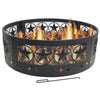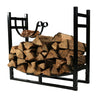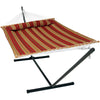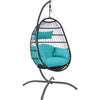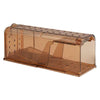Keeping bugs out of your yard is essential for maintaining a comfortable and enjoyable outdoor space. Whether you're planning a backyard barbecue, playing with your kids, or simply relaxing in the fresh air, the last thing you want is to be pestered by mosquitoes, ants, or other unwelcome insects. By taking a few proactive steps, you can create a bug-free environment that allows you to fully enjoy your yard throughout the year. In this post, we'll explore effective strategies for deterring pests and keeping your outdoor area a pleasant retreat.

Good Bugs vs. Bad Bugs
Not all bugs in your yard are bad. In fact, some insects play a crucial role in maintaining a healthy garden ecosystem. Beneficial bugs like ladybugs, bees, and butterflies help pollinate plants, control harmful pests, and promote overall plant health. Ladybugs, for example, feed on aphids and other harmful insects, while bees are essential for pollinating flowers, fruits, and vegetables. On the other hand, pests like mosquitoes, ticks, and certain types of beetles can damage plants, spread diseases, and make spending time outdoors unpleasant. Understanding the difference between good and bad bugs is key to managing your yard effectively—by encouraging the presence of beneficial insects while taking measures to deter the harmful ones, you can create a balanced, thriving garden environment.
Keeping good bugs in your yard without attracting bad ones requires a balanced approach that supports beneficial insects while discouraging pests. Start by planting a variety of native plants and flowers that attract pollinators like bees and butterflies, such as lavender, marigolds, and sunflowers. These plants provide nectar and habitat for beneficial insects but are less likely to draw harmful pests. You could plant them in planters, raised beds, or in the ground. Additionally, avoid using chemical pesticides, which can harm both good and bad bugs indiscriminately. Instead, opt for natural pest control methods, such as introducing predators like ladybugs or using neem oil to target specific pests. By maintaining a diverse and healthy garden with proper plant selection and natural pest management, you can create an environment where beneficial insects thrive, keeping your yard vibrant and healthy while minimizing the presence of harmful bugs.
Tips for Keeping Pests Out of Your Yard

Tip #1: Remove Standing Water
Mosquitoes and other pests thrive in standing water, where they lay their eggs. Regularly empty and clean items like bird baths, flowerpots, and gutters to prevent water from accumulating. Consider installing a drainage system in areas where water tends to pool, and keep your lawn properly graded to avoid creating breeding grounds for mosquitoes.

Tip #2: Use Natural Repellents
Planting pest-repellent herbs and flowers like citronella, lemongrass, marigolds, and lavender can naturally deter bugs. These plants emit scents that are unpleasant to pests but enjoyable for people. Humane and ultrasonic pest control devices are additional great options for keeping your yard free from pests and unwanted insects. You can also use essential oils derived from these plants, mixing them with water in a spray bottle to apply around your yard or patio. Alternatively, tiki torches using citronella fuel are another good way to deter mosquitoes when you are spending time outdoors.

Tip #3: Keep the Lawn Trimmed
Regularly mowing your lawn and trimming overgrown bushes and shrubs reduces the hiding places for pests like ticks, fleas, and ants. A well-maintained yard is less inviting to pests, making it easier to spot and address any infestations before they become a problem. Make sure the yard remains clear of trash with a covered trash bin to protect it from getting all over the lawn.

Tip #4: Seal Entry Points
Inspect the exterior of your home for cracks, gaps, or openings where bugs can enter. Seal these entry points with caulk or weatherstripping to prevent pests from making their way into your home. Pay close attention to areas around doors, windows, and utility lines.

Tip #5: Compost Carefully
While composting is great for your garden, it can attract pests if not managed properly. Keep your compost pile away from your home and regularly turn it to aerate and speed up the decomposition process. Avoid composting meat, dairy, and oily foods, as these can attract unwanted pests like rodents and flies.

Tip #6: Use Mulch Wisely
Mulch helps retain soil moisture and suppress weeds, but it can also attract pests if not used carefully. Keep mulch at least a few inches away from the foundation of your home to prevent pests like termites from using it as a bridge into your house. Consider using cedar or cypress mulch, which naturally repels insects.

Tip #7: Introduce Natural Predators
Encourage the presence of natural predators like birds, frogs, and beneficial insects that feed on harmful pests. You can do this by providing habitats, such as bird houses, bird feeders, bat boxes, or a small pond. Predators help keep the pest population in check, reducing the need for chemical interventions.

Tip #8: Use LED Lighting
Switching to LED lighting in your yard is not only energy efficient but also an effective way to reduce the presence of bugs and pests. Unlike incandescent bulbs, which emit a broad spectrum of light that attracts many insects, LED lights produce less ultraviolet (UV) light and minimal heat. Bugs are less drawn to this type of lighting, making it a better choice for outdoor spaces where you want to keep pests at bay. By installing LED lights around your patio, garden, and entryways, you can illuminate your yard without inviting a swarm of unwanted insects, helping you enjoy your outdoor space more comfortably.





